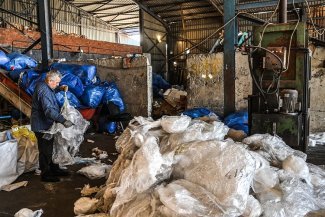Today’s agriculture is not designed to produce food, but rather money. Some technological advances could be very useful in improving the productivity and sustainability of our agricultural activities. Under the current capitalist socio-economic system, however, all innovation is placed at the service of profit.
In the mid-20th century, the so-called Green Revolution changed humanity’s relationship with agriculture. A series of technological advances in high-yielding varieties of rice and wheat seeds, along with irrigation systems and new fertilisers and pesticides – which marked the official entry of the chemical industry into the field – brought about a dramatic increase in agricultural productivity. Three decades later, this model adapted to the financialisation of the economy brought about by neoliberal policies and agribusiness was born. It has since taken root across the globe in the form of vast monocultures for the export of products that serve as raw materials for various industries. For example, one of the many uses for the palm oil, soya and sugar cane grown in monocultures is the production of biofuels.
After seven years of research on the ground in countries like Colombia, Guatemala, Ecuador, Argentina, Cameroon, Malaysia, Indonesia and Thailand, it is our* conclusion that monocultures have left a complicated legacy in the territories where they have been put into practice. Their notable socio-environmental impacts include: deforestation and loss of biodiversity; desertification and land degradation; the expulsion of indigenous and rural communities; contamination of soil, water and air due to the use of agrochemicals; the appearance of diseases linked to these chemicals; and precarious working conditions on plantations.
Despite all of these negative impacts, the Green Revolution continues to be touted as the only solution against hunger. In his book Enlightenment Now: The Case for Reason, Science, Humanism and Progress, Steven Pinker provides data that supports the optimistic and questionable idea that we are on the right track: in 1947, the percentage of malnourished people was 50 per cent; today, it is around 13 per cent, despite the continued growth of the world’s population.
But agribusiness is not necessarily responsible for this decrease in hunger. Studies by the Food and Agriculture Organisation of the United Nations (FAO) and the Action Group on Erosion, Technology and Concentration (ETC Group) confirm that more than 70 per cent of the food that we eat is in fact produced by small-scale farming while monocultures are focused on the production of various industrial products rather than food.
Without getting into the data that Pinker uses, the underlying problem is that data, in its supposed neutrality, always obscures an ideological bias, showing one thing while hiding another. Let’s take the example of the Montes De María, a territory in Colombia where palm monoculture has made rapid advances over the last 20 years. If we look solely at the amount of monetary income it has produced, it would be easy to conclude that poverty has diminished and the standard of living has increased since the arrival of the palm crops. But the reality that we have observed on the plantations is very different. Local residents tell us that before the arrival of monoculture, they grew their own food, fished and traded. They assure us that they lived in abundance and needed little money. Today, they have to buy everything. There is a shortage of land to cultivate, contamination from the dam has killed the fish and the only water that reaches their homes is contaminated by the agrochemicals used on the palm crops. They earn more money but their lives are far more precarious. One of the women who hosted us summed it up this way: “Our quality of life used to be better, not because we had technology but because we lived well.”
Another illustrative example concerns productivity: in the 19th century, 25 full-time workers were needed to harvest one tonne of grain; today, one person can do it in six minutes. However, in the capitalist and neo-colonial structures in which we live, this improvement in productivity results not in the well-being of workers – who continue to work 12 to 14 hours a day for miserable wages, if not in conditions tantamount to slavery – but in increasing unemployment.
The risks of GMOs
While the Green Revolution has brought about significant advances, it has also prioritised the most lucrative varieties over more nutritious ones and has failed to preserve the biodiversity of species and seeds. As Australian researcher Bill Mollison puts it, the underlying problem is that today’s agriculture is not designed to produce food, but rather money. Some technological advances could be very useful in improving the productivity and sustainability of our agricultural activities. Under the current capitalist socio-economic system, however, all innovation is placed at the service of profit.
One good example is genetically modified organisms (GMOs). At first glance, the idea of intervening in a plant’s DNA in order to improve its nutritional qualities or its yield doesn’t seem so bad. But the GMOs on the market today are engineered for the sole purpose of increasing the profits of the four companies that control the global market (Corteva Agriscience, BASF, Bayer-Monsanto and the recently merged Syngenta and Chem China). GMOs are usually altered to tolerate very powerful herbicides and pesticides based on such toxic substances as the controversial glyphosate, which leaves behind significant traces in both land and bodies. In Argentina, for example, where more than 60 per cent of cultivated land is planted with soya (99 per cent of which is genetically modified), various studies have shown that the rainwater in large swathes of the country contains glyphosate. The populations surrounding the plantations also suffer the consequences of fumigations in the form of respiratory and dermatological diseases, cancer, foetal malformations and miscarriages.
Those who defend this dominant model often choose to ignore the disturbing fact that this form of industrial and extractive agriculture is depleting soil nutrients and sources of freshwater and jeopardising future generations, not to mention non-human species.
Finally, at a time when so many are alarmed by population growth and the danger of hunger, many forget that this daily – and very avoidable – tragedy has much more to do with distribution than with food production. According to estimates by the FAO, current production could feed the 9.05 billion human beings who will inhabit the planet in 2050, simply by avoiding waste: we currently throw away 30 per cent of the food produced. This is not to mention the quality (not just quantity) of the calories that we ingest: in places where diets are largely based on ultra-processed food, cardiovascular disease, diabetes and obesity often coexist with nutrient deficiency.
In short, we are faced with two competing models of development, one that centres on the accumulation of capital in fewer and fewer hands, and another that centres on reproducing life through the sustainable production of healthful food. The latter model can and should make use of scientific and technological advances but we must urgently begin to rethink the fact that something as essential as our food is in the hands of a small number of multinationals. As Henry Kissinger said: “Control the oil and you control nations; control food and you control the people.”










